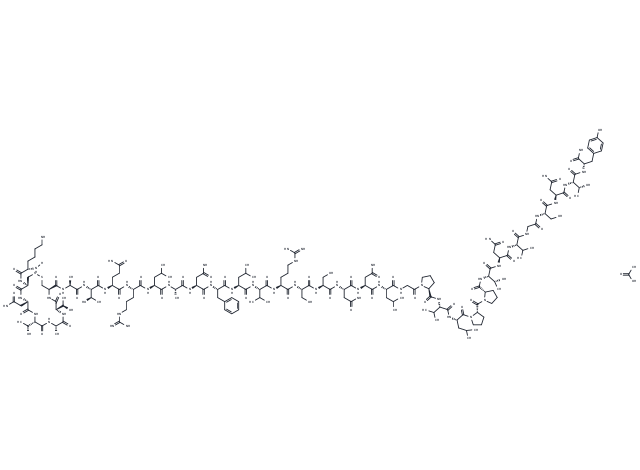Shopping Cart
- Remove All
 Your shopping cart is currently empty
Your shopping cart is currently empty

Amylin, amide, rat acetate is a potent and high affinity ligand of AMY1 and AMY3 receptors and variably of AMY2 receptors.

| Pack Size | Price | Availability | Quantity |
|---|---|---|---|
| 1 mg | $178 | In Stock | |
| 5 mg | $436 | In Stock | |
| 10 mg | $592 | In Stock | |
| 25 mg | $912 | In Stock | |
| 50 mg | $1,180 | In Stock | |
| 100 mg | $1,660 | In Stock | |
| 200 mg | $2,230 | In Stock |
| Description | Amylin, amide, rat acetate is a potent and high affinity ligand of AMY1 and AMY3 receptors and variably of AMY2 receptors. |
| In vivo | Amylin is an important 37 amino acid glucoregulatory hormone with great potential to target metabolic diseases. Amylin is a member of the calcitonin (CT) family of peptides, which includes CT itself, the CGRPs comprising two variants (αCGRP and βCGRP), adrenomedullin (AM) and AM2 (intermedin). Amylin is a centrally acting, neuroendocrine hormone synthesized with insulin in the beta cells of pancreatic islets. Amylin regulates glucose homeostasis by inhibiting gastric emptying, inhibiting the release of the counter-regulatory hormone glucagon and inducing meal-ending satiety. Amylin functions as a glucoregulatory and satiety-inducing hormone, which is protective against postprandial spikes in blood glucose and overeating.[1] |
| Molecular Weight | 3980.45 |
| Formula | C169H276N52O55S2 |
| Smiles | [H]N[C@H](C(N[C@H]1CSSC[C@@H](C(N[C@H](C(N[C@H](C(N[C@H](C(N[C@H](C(N[C@H](C(N[C@H](C(N[C@H](C(N[C@H](C(N[C@H](C(N[C@H](C(N[C@H](C(N[C@H](C(N[C@H](C(N[C@H](C(N[C@H](C(N[C@H](C(NCC(N2CCC[C@H]2C(N[C@H](C(N[C@H](C(N3CCC[C@H]3C(N4CCC[C@H]4C(N[C@H](C(N[C@H](C(N[C@H](C(NCC(N[C@H](C(N[C@H](C(N[C@H](C(N[C@H](C(N)=O)CC5=CC=C(C=C5)O)=O)[C@H](O)C)=O)CC(N)=O)=O)CO)=O)=O)C(C)C)=O)CC(N)=O)=O)[C@H](O)C)=O)=O)=O)CC(C)C)=O)C(C)C)=O)=O)=O)CC(C)C)=O)CC(N)=O)=O)CC(N)=O)=O)CO)=O)CO)=O)CCCNC(N)=N)=O)C(C)C)=O)CC(C)C)=O)CC6=CC=CC=C6)=O)CC(N)=O)=O)C)=O)CC(C)C)=O)CCCNC(N)=N)=O)CCC(N)=O)=O)[C@H](O)C)=O)C)=O)NC([C@H]([C@H](O)C)NC([C@@H](NC([C@H]([C@H](O)C)NC([C@@H](NC1=O)CC(N)=O)=O)=O)C)=O)=O)=O)CCCCN.CC(O)=O |
| Relative Density. | no data available |
| Storage | keep away from moisture | Powder: -20°C for 3 years | In solvent: -80°C for 1 year | Shipping with blue ice. |

Copyright © 2015-2025 TargetMol Chemicals Inc. All Rights Reserved.